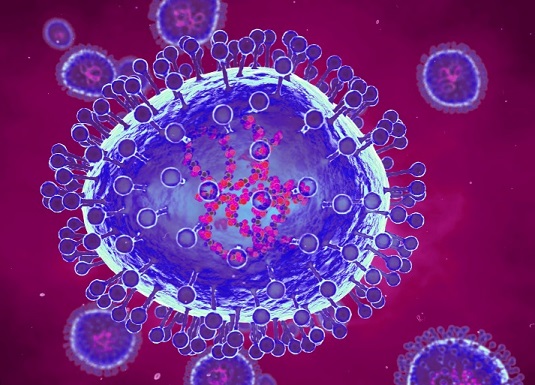Nikhil Prasad Fact checked by:Thailand Medical News Team Jan 11, 2025 3 months, 2 days, 5 hours, 5 minutes ago
Medical News: Human metapneumovirus (HMPV) is a viral agent that significantly contributes to respiratory illnesses, especially among young children, older adults, and individuals with weakened immune systems. Despite its high prevalence, no vaccines or specific treatments are available for HMPV infections. Researchers from the Institute for Glycomics at Griffith University, Queensland, Australia, have delved into understanding the virus’s unique mechanisms of infection. Their recent findings illuminate the potential for groundbreaking treatments, offering hope to millions affected globally.
 Human Metapneumovirus (HMPV) and Sugar Structures on Human Cells
The Role of Sugars in Viral Infections
Human Metapneumovirus (HMPV) and Sugar Structures on Human Cells
The Role of Sugars in Viral Infections
Viruses often exploit the sugar-coated surfaces of human cells to latch onto and initiate infections. These sugars, or glycans, are critical in biological processes, and their interactions with viruses provide insights into designing targeted therapies.
Previous studies identified heparan sulfate proteoglycans (HSPGs) as a key receptor for HMPV. HSPGs are abundant on human airway epithelial cells and act as gateways for viral entry. However, the specific details of how HMPV recognizes and binds to human cells remained unclear.
This
Medical News report focuses on the recent study that unveiled the intricate relationship between HMPV and the glycan structures on human cells.
Researchers used innovative techniques to dissect these interactions, opening the door to therapeutic advancements.
A Multidisciplinary Approach to Studying Glycans
The team employed a variety of state-of-the-art methods, including glycan microarrays and surface plasmon resonance (SPR), to identify and confirm the sugar structures recognized by the HMPV fusion (F) protein. The F protein plays a pivotal role in viral attachment, membrane fusion, and entry into human cells.
Their findings revealed that HMPV F binds to diverse glycan motifs beyond HSPGs. These include Galβ1-3/4GlcNAc moieties, which are similar to the N-linked and O-linked glycans predominantly found in the human lung epithelium.
Key findings indicated that these glycans not only facilitate viral binding but also have the potential to block HMPV infection. Among the tested glycans, lacto-N-neotetraose (LNnT) exhibited the strongest inhibitory effect against viral binding in cell-based assays.
Groundbreaking Observations
The study’s findings highlight several groundbreaking observations:
-Expanded Glycan Recognition: The HMPV F protein interacts with a wide array of glycan structures, including not only HSPGs but also chondroitin sulfate, hyaluronic acid, and various fucosylated glycans. This broad specificity suggests that the virus uses multiple pathways to attach to host cells.
-Lacto-N-Neotetraose as a Potent Inhibitor: LNnT was
identified as the most effective glycan in inhibiting HMPV binding. In dose-dependent experiments, LNnT demonstrated up to 98% reduction in viral attachment, marking it as a promising candidate for therapeutic development.
-Sialylation and Fucosylation Impact: The presence of sialic acid and fucose residues on glycans appeared to enhance their interaction with the HMPV F protein. However, certain variations in these sugar structures also influenced their ability to inhibit viral binding.
-Potential for Therapeutic Glycomimetics: By mimicking these glycan structures, researchers believe they can develop glycomimetics - synthetic molecules designed to block viral entry. Such treatments could offer a targeted approach to preventing or mitigating HMPV infections.
Detailed Methodology
The study utilized glycan arrays to screen a broad library of sugar structures. Recombinantly expressed HMPV F proteins were exposed to these arrays to identify binding patterns. Further validation was achieved using SPR, which quantified the strength of interactions between the viral protein and various glycans.
Additionally, the team conducted nuclear magnetic resonance (NMR) spectroscopy to pinpoint the atomic-level interactions of LNnT with HMPV F. These experiments confirmed that LNnT binds specifically to the F protein’s active regions, potentially interfering with the virus’s ability to attach to human cells.
Implications for Treatment
The study’s findings offer a roadmap for developing antiviral therapies against HMPV. By leveraging the identified glycan motifs, researchers can design inhibitors that block the virus’s entry into host cells. These glycomimetics could be particularly valuable for high-risk populations, such as children under two years old, the elderly, and immunocompromised individuals.
Moreover, understanding the virus’s reliance on specific glycans highlights potential strategies for vaccine development. By targeting the viral glycan-binding domains, vaccines could preemptively neutralize HMPV, reducing its ability to infect human cells.
Conclusion
This research marks a significant step forward in understanding HMPV’s mechanisms of infection. By identifying the glycan structures critical to viral binding, the study paves the way for innovative treatments and preventative measures. The findings underscore the importance of multidisciplinary approaches in tackling complex biological challenges.
Future studies will focus on optimizing glycomimetic designs and exploring their efficacy in clinical settings. As these therapies progress, they could transform the landscape of respiratory viral infections, providing much-needed relief to vulnerable populations worldwide.
The study findings were published in the peer-reviewed Journal of Virology.
https://journals.asm.org/doi/10.1128/jvi.01641-23
For the latest HMPV news, keep on logging to Thailand
Medical News.
Read Also:
https://www.thailandmedical.news/news/french-researchers-warn-that-hmpv-infections-could-possibly-cause-chronic-lymphocytic-leukemia-like-lymphocytosis
https://www.thailandmedical.news/news/mexico-reports-first-death-from-hmpv-hundreds-possibly-infected-amidst-speculations-a-new-subtype-has-emerged
https://www.thailandmedical.news/news/as-crisis-escalates-in-china-locals-rush-to-stock-up-on-xofluza-which-is-not-effective-against-human-metapneumovirus-hmpv
https://www.thailandmedical.news/articles/hmpv-human-metapneumovirus
